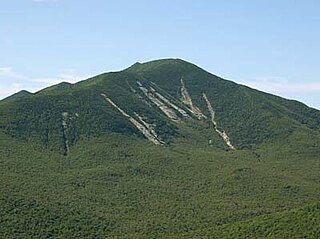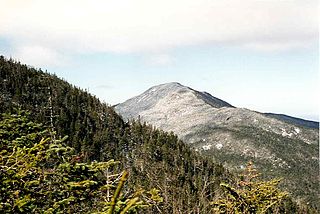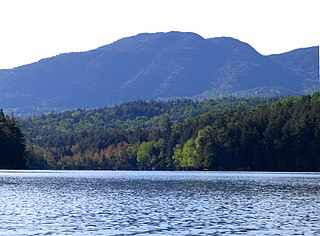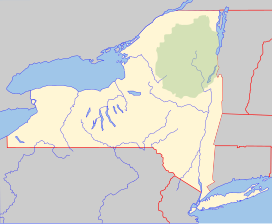
Mount Marcy is the highest point in the U.S. state of New York, with an elevation of 5,343.1 feet (1,628.6 m). It is located in the Town of Keene in Essex County. The mountain is in the heart of the High Peaks Wilderness Area in Adirondack Park. Like the surrounding Adirondack Mountains, Marcy was heavily affected by large glaciers during recent ice ages, which deposited boulders on the mountain slopes and carved valleys and depressions on the mountain. One such depression is today filled by Lake Tear of the Clouds, which is often cited as the highest source of the Hudson River. The majority of the mountain is covered by hardwood and spruce-fir forests, although the highest few hundred feet are above the tree line. The peak is dominated by rocky outcrops, lichens, and alpine plants. The mountain supports a diverse number of woodland mammals and birds.
The Adirondack High Peaks are a set of 46 mountain peaks in the Adirondack Mountains of New York state. They have been popular hiking destinations since the late 1920s, when the list of peaks was published in Russell Carson's book Peaks and Peoples of the Adirondacks. Those who have climbed all 46 High Peaks are eligible to join the Adirondack Forty-Sixers club.

The Adirondack Forty-Sixers are an organization of hikers who have climbed all forty-six of the traditionally recognized High Peaks of the Adirondack Mountains. They are often referred to just as 46ers. As of 2021, there were nearly 14,000 registered forty-sixers. The organization primarily supports efforts to maintain the Adirondack High Peaks Wilderness, and encourages aspiring members through a correspondents program.

Algonquin Peak is a mountain in the MacIntyre Range of the Adirondack Mountains of New York. It is the second highest mountain in New York, with an elevation of 5,114 feet (1,559 m), and one of the 46 High Peaks in Adirondack Park. It is located in the town of North Elba in Essex County. The first recorded ascent of the mountain was made on August 8, 1837, by a party led by New York state geologist Ebenezer Emmons. It was originally named Mount McIntyre, after Archibald McIntyre, but this name was eventually applied to the entire range. Surveyor Verplanck Colvin added the name "Algonquin" in 1880. This name came from the peak reputedly being on the Algonquian side of a nearby informal boundary between the Algonquian and their Iroquois neighbors, although no such boundary existed in reality.

Mount Haystack is a mountain in the Great Range of the Adirondack Mountains of New York. With an elevation of 4,960 feet (1,510 m), it is the third highest mountain in New York and one of the 46 High Peaks in Adirondack Park. It is located in the town of Keene in Essex County. The first recorded ascent of the mountain was made by mountain guide Orson Schofield Phelps in 1849, accompanied by Almeron Oliver and George Etsy. Phelps gave the mountain its current name based on its appearance to a haystack, and later cut the first trail to the summit in 1873. The summit is an alpine zone above the treeline, which offers a view of nearby Mount Marcy and Panther Gorge.

Mount Skylight is a mountain in the Adirondack Mountains of New York. Skylight is the fourth highest peak in New York, with an elevation of 4,925 feet (1,501 m), and one of the 46 High Peaks in Adirondack Park. It is located in the town of Keene in Essex County. The mountain was given its name by artist Frederick S. Perkins and guide Orson Schofield Phelps in 1857, due to a rock formation on the peak resembling a window. Phelps would later make the first known ascent of the peak with surveyor Verplanck Colvin and two others on August 28, 1873.

Dix Mountain is a mountain in the Dix Range of the Adirondack Mountains of New York. With an elevation of 4,840 feet (1,480 m), it is the sixth highest peak in New York and one of the 46 High Peaks of the Adirondack Park. It is located roughly on the boundary between the towns of North Hudson and Keene in Essex County. The crest of the peak consists of a very narrow ridge, which continues to the southeast and rises to a subsidiary peak named Beckhorn, then continues south to other peaks of the Dix Range. The summit is also in an alpine zone above the treeline. The ridge offers unobstructed views of Elk Lake to the southwest, the Great Range to the northwest, and Lake Champlain and the Green Mountains to the east.

Iroquois Peak is a mountain in the MacIntyre Range of the Adirondack Mountains in New York. It is the eighth-highest peak in New York, with an elevation of 4,843 feet (1,476 m), and one of the 46 High Peaks in Adirondack Park. It is located in the town of Newcomb in Essex County. Although the mountain does not have an officially maintained trail, a well-maintained herd path marked by cairns exists between the summits of Iroquois Peak and Algonquin Peak, 1.1 miles (1.8 km) to the northeast.

Mount Colden is a mountain in the Adirondack Mountains of New York. It is the eleventh-highest peak in New York, with an elevation of 4,715 feet (1,437 m), and one of the 46 High Peaks in Adirondack Park. It is located in the town of Keene in Essex County. The peak is named after David C. Colden, an investor in the McIntyre Iron Works at Tahawus. The mountain is known for the Trap Dike on its west face, which forms a large crevice running up the mountain that can be clearly seen from Avalanche Lake. The summit of the mountain can be reached by two hiking trails, which are frequently combined to form a circuit through Avalanche Pass, or by climbing the Trap Dike. The summit is in an alpine tundra zone above the treeline, and offers views of surrounding mountains and lakes.

Gray Peak is a mountain located in the town of Keene in Essex County, New York. It is the seventh-highest of the Adirondack High Peaks, with an elevation of 4,826 feet (1,471 m), and is located in close proximity to Mount Marcy, the highest peak in New York. Gray Peak is southwest of Mount Marcy and southeast of Mount Colden. The first recorded ascent of the peak was made on September 16, 1872, by surveyor Verplanck Colvin and guide Bill Nye. It was named for Asa Gray by Colvin.

Rocky Peak Ridge is the twentieth highest peak in the High Peaks Region of the Adirondack Park of New York, United States. The name of the mountain is due to its geology, a rocky ridge to the east of the better known Giant Mountain. The long, bare ridge is unusual in the Adirondacks; it resulted from the last great forest fire in the region, in 1913.

Gothics is a mountain in the Great Range of the Adirondack Mountains in New York. It is the tenth-highest peak in New York, with an elevation of 4,734 feet (1,443 m), and one of the 46 High Peaks in Adirondack Park. It is located in the town of Keene in Essex County. The mountain is named due to the resemblance of its three arched peaks and large rock slides to Gothic architecture. Although the name has been attributed to Orson Schofield Phelps and Frederick W. Perkins, who named several peaks during an 1857 ascent of Mount Marcy, other evidence shows the name Gothics in use at least as early as 1850. The earliest recorded ascent was made on October 11, 1875, by Verplanck Colvin, Roderick L. McKenzie, and Ed Phelps, although an unrecorded ascent was likely made earlier by James J. Storrow and Orlando Beede. The summit of Gothics is an alpine tundra zone, and on clear days views of 30 nearby peaks are available, as well as the Upper and Lower Ausable Lakes.
The High Peaks Wilderness Area is the largest wilderness area of the Forest Preserve in the U.S. state of New York. It is located in three counties and six towns in the Adirondack Park: Harrietstown in Franklin County, North Elba, Keene, North Hudson and Newcomb in Essex County and Long Lake in Hamilton County.

Basin Mountain is a mountain in the Great Range of the Adirondack Mountains in New York. It is the ninth-highest peak in New York, with an elevation of 4,826 feet (1,471 m), and one of the 46 High Peaks in Adirondack Park. It is located in the town of Keene in Essex County. The peak was named either for the basins formed between knobs on its slopes or the large basin to its southeast formed by it and the surrounding mountains. The name Basin was most likely coined by Orson Schofield Phelps and Frederick W. Perkins in 1857 during an ascent of Mount Marcy. The earliest appearance of the name in writing was made by surveyor Verplanck Colvin in 1873.
South Dix is a mountain located in Essex County, New York. The mountain is part of the Dix Range, named after John A. Dix (1798–1879), New York Secretary of State in 1837, and later Governor. The name is being changed to Carson Peak, after Russell M.L. Carson (1884–1961), author of Peaks and People of the Adirondacks. South Dix is flanked to the northeast by Grace Peak, to the northwest by Hough Peak, and to the southwest by Macomb Mountain.
Macomb Mountain is a mountain located in Essex County, New York. The mountain is named after Maj. Gen. Alexander Macomb (1782–1841), who won acclaim during the War of 1812 at the Battle of Plattsburgh, and served as Commanding General of the United States Army (1828–1841).

Phelps Mountain is a mountain located in Essex County, New York. The mountain is named after Orson Schofield "Old Mountain" Phelps (1817–1905), who cut the first trail up Mount Marcy and named several of the Adirondack peaks. It is the 32nd highest peak in New York. Phelps Mountain is flanked to the southeast by Table Top Mountain.

Seward Mountain is a mountain located in Franklin County, New York, of which it is the highest point. Seward Mtn. is named after William H. Seward (1801–1872), Governor of New York (1839–1842), and United States Secretary of State (1861–1869). The mountain is part of the Seward Mountains of the Adirondacks. Seward Mountain is flanked to the southwest by Donaldson Mountain, and to the east faces Seymour Mountain across Ouluska Pass.

Ampersand Mountain is a 3,352 ft (1,021.7 m) mountain in Franklin County in the High Peaks Wilderness Area of the northeastern Adirondacks, west of the High Peaks proper in New York State. The trail up the mountain begins on New York State Route 3 8.1 miles (13.0 km) southwest of the village of Saranac Lake, near Middle Saranac Lake; it is a popular day hike. The mountain takes its name from nearby Ampersand Creek, so named because it twists and turns like the ampersand symbol. The summit is bare rock, with extensive views of the High Peaks to the east and the Saranac Lakes to the west. Stony Creek Mountain is located west-southwest of Ampersand Mountain. The mountain is notable as the land surrounding its hiking trail's initial ascent is generally acknowledged as unlogged old growth forest.

The MacIntyre Mountains or MacIntyre Range is a range of mountains in the High Peaks region of the Adirondacks, due west of Mount Marcy, in northeastern New York State. The range runs 8 miles (13 km) from southwest to northeast. Its sheer southwest slope makes up one side of Indian Pass, and a northeastern spur forms the cliffs of Avalanche Pass. From southwest to northeast, the range includes Mount Marshall, Iroquois Peak, Boundary Peak, Algonquin Peak, and Wright Peak. Algonquin is the second-highest peak in the Adirondacks.

















